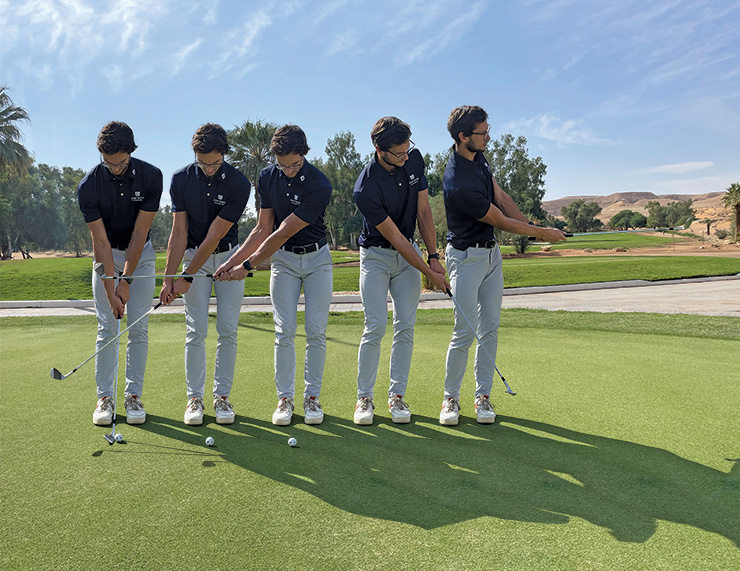A chip is a lofted shot we hit when we are close to the green, but not quite on the dancefloor. The shot itself can be low or high depending on the situation we find ourself in on the course, which is mainly controlled by which club we choose to use. To get a visual for a chip, try throwing a ball high up in the air then low, how easy or difficult is it to get distance and how does the amount of roll differ? When trying the shot below, if you don’t have access to a short-game area, try it out on the driving range instead.
Set-up
Hold: Just like in our introduction to the full swing, for the right-handed golfer, place the left hand at the top of the club, with the right hand below. Experiment with holding lower down on the grip, towards the shaft of the club (above right). The swing when we are chipping is small, so making the club smaller too can make it easier to control.
Posture & stance: Starting from the ground up. Keep the feet close together, around the width of a clubhead, with the ball in the centre of the stance. Hold the club level with the ground, elbows close to the body and tilt forward from the waist with a small knee flex until head of the golf club is resting on the ground. For the right-handed golfer our weight wants to favour the left side as we address the ball.
Swing
Distance control: Just as in putting, the distance of the shot is primarily controlled by the speed of the club which can be altered by rhythm and length of the swing. Making a longer swing the club will move faster, hitting the ball further, the shorter the swing the slower the club and the shot will go shorter. Depending on the loft of the club we are using, we can not only change the height of the shot but the distance too.
Strike: If this is your first time hitting shots from the grass, don’t be afraid of hitting the ground. The club should make contact but not dig, if it does then chances are the face is too far left (below). Try keeping the grip of the club pointing straight up at address and try to return it to this point as we swing down.
Practice
Impact: Controlling the clubs lowest point and how it interacts with the ground is one of the most important aspects of all iron shots in golf, and with chipping it is no exception. Give this simple practice drill a try to improve your control over where the club hits the ground, making it easier to get good contact on the ball.
Start by setting a tee in the ground, or use a bottle cap if hitting from a mat. Make a swing and try to hit the tee, the lower we make the tee the harder this drill is, so begin with the tee 1-2cm above the ground. With each successful hit, lower it slightly, until we no longer need the tee and are brushing the club on the ground. As we make contact with the ground some grass should be dislodged, but remember that we should not be ‘digging’.
Target practice: Start with hitting a chip with a low-lofted club such as a 7 iron, and take note of where it finishes. Change to a more lofted club, such as an 8 iron or 9 iron, and try to hit the ball the same distance. Once we can get the ball to finish close to the first, change to a more lofted club again such as the sand wedge. If we are able to hit the ball the same distance with a variety of clubs, it massively helps us to learn how the loft impacts the flight and roll of the ball.
There is no correct club or shot to play in any given situation, just whatever will get us closest to the hole most often. Sometimes the best chip is actually a putt, don’t be afraid to experiment and be creative around the green.
Scott Edwards is a member of the PGA Professionals team at Golf Saudi-managed Riyadh Golf Club









